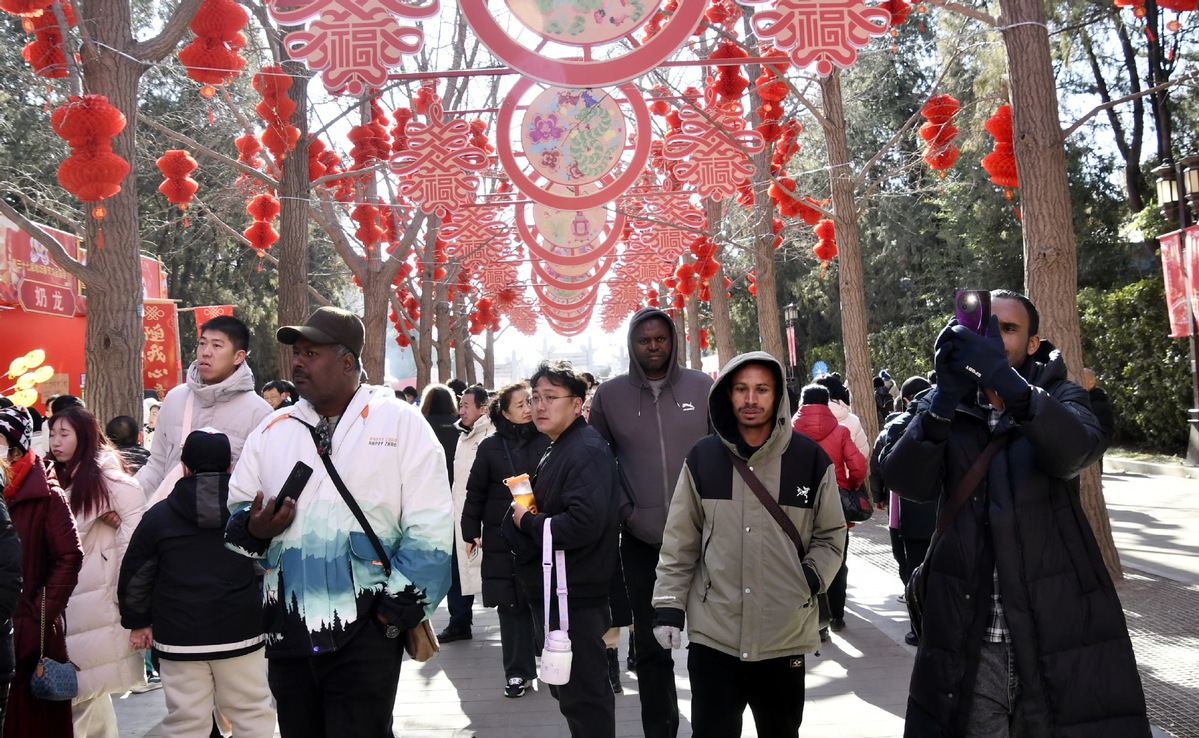Spring Festival showcases Chinese culture to the world
From:China DailyAuthor: 2025-02-17 14:30

Data shows that around 51 townships and villages across China welcomed foreign visitors for the first time, following the country's expanded visa-free policies. [Photo/Xinhua]
Celebrating Chinese New Year at my in-laws' for the past five years, this year marked the first time I encountered foreigners on a plane.
My mother-in-law's home is situated in a small county in East China's Anhui province. In recent years, efforts have been made to boost the local economy through the development of the Mount Tianzhu tourist area. The scenery at Mount Tianzhu is truly breathtaking, reminiscent of classical Chinese landscape paintings, but the visitors mostly consist of locals from nearby cities.
However, nothing could compare to the astonishment I felt on the first day of the Chinese New Year when I witnessed foreigners worshipping at a local temple. They appeared to be backpackers, mimicking the gestures of Chinese worshippers as they solemnly held three sticks of incense, eyes closed in what seemed like a moment of prayer.
After a brief conversation, one of the tourists described her Chinese New Year journey as "an unforgettable cultural journey". Traveling from cities like Shanghai, Hangzhou and Suzhou to Anhui province, she was enchanted by the diverse traditions unique to each region. Her future plans included visiting Fujian and Guangdong provinces.
Lesser-known destinations are gaining popularity among foreign tourists beyond major cities and famous landmarks, and this trend was also proven by data from large travel portals.
According to data from Qunar, thanks to expanded visa-free policies, among the Chinese cities foreigners are booking flights to, apart from historically and culturally rich cities like Beijing, Chengdu, Shanghai, Guangzhou, Xi'an and Hangzhou, there has been a growing trend of foreigners exploring second and third-tier cities, with 10 new destinations added compared to the previous year. These new destinations include Baotou, Dali, Nantong and Taizhou, etc.
Trip.com's data reveal that orders for inbound tourism to intangible cultural heritage destinations such as Shijiazhuang, Fuzhou and Xi'an increased by 50 percent, 52 percent and 97 percent, respectively, compared to last year's Spring Festival. On Trip.com's overseas platform, tickets for intangible heritage-related activities such as lantern festivals, temple fairs and traditional dramas increased nearly 7.5 times compared to the previous year.
Clearly, the momentum of "China Travel" continues, and the influx of international traffic on social media platforms at the beginning of this year has sparked a wave of enthusiasm among netizens. The combination of UNESCO intangible cultural heritage — Spring Festival — and the high cost-effectiveness of Chinese tourism has left foreign tourists in awe.
As the first Spring Festival following the successful application for UNESCO intangible cultural heritage this year, experiencing local customs and participating in intangible heritage activities have become major highlights. Trip.com said there was a doubling in search interest for intangible heritage hotspots such as Kaifeng in Henan province, Fuzhou and Putian in Fujian province, Shantou in Guangdong province, and Huangshan in Anhui province, among others.
My family and I have also deeply experienced this. The Chinese New Year atmosphere in my in-laws' hometown started brewing from the twelfth month of the lunar calendar. Under the old trees at the village entrance, the elderly chatted while taking stock of the cured meat, smoked sausages for the festival, as well as sunflower seeds and peanuts for guests and candies for children. Walking through the village, the air was filled with the aroma of traditional pastries being made in households. Back home, my husband and children put up Spring Festival couplets and auspicious words. Outside, the sound of firecrackers filled the air, accompanied by endless blessings.
The inheritance of culture can truly soothe the exhaustion and troubles of travelers after a year of wandering. Encountering foreigners participating in traditional Chinese intangible cultural heritage activities during the Spring Festival was truly moving and filled me with pride. Seeing foreign friends being drawn to our intangible cultural heritage, I came to realize that Spring Festival is not only our festival, but also a window to showcase Chinese culture to the world.
Edit:董丽娜
The copyright of the article and the picture belongs to the original author. If there is any infringement, please contact to delete it